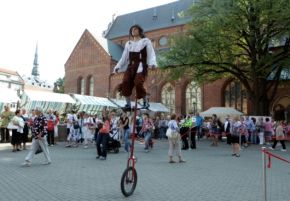Analytics, Financial Services, Latvia, Real Estate, Society, Wages
International Internet Magazine. Baltic States news & analytics
Thursday, 25.04.2024, 16:55
At the beginning of 2015, the population in Riga comprised 32% of the total population of Latvia
 Print version
Print version |
|---|
Of which 358 thsd were women, but 283 thsd – men. Out of all Riga population 14.5% or 93 thsd were under working age (until 14 years), 62.1% or 398 thsd – of working age (15 – 61 years) and 23.4% or 150 thsd – over working age (over 62 years). Riga has the largest population density – at the beginning of 2015, 2 109 persons inhabited one square kilometre, for comparison, in Latvia – on average 31 person per one square kilometre.
In 2014 there were 7 514 newborns in Riga, which is the highest indicators since 2008 (8 272). Out of all newborns 3 875 were boys and 3 639 – girls. Record number of newborns in Riga was in 1986 when 13 079 babies were born.
In 2014, average age of mother at the time when first baby is born was 28.7 years, which is the highest indicator among all cities under state jurisdiction. For comparison, in Latvia average indicator is 27.2 years.
Last year Riga had the largest average monthly wages and salaries after taxes – EUR 633, which is EUR 73 more than average in Latvia (EUR 560). Average monthly wages and salaries in Riga have increased by EUR 50 as compared to 2013. During ten years average monthly wages have risen by 394 euros (in 2004 – EUR 239).
As compared to other cities under state jurisdiction, Riga has the highest share of population with higher education (including doctor's degree) – 32.1%. In Centre, Vecpilsēta and Mežaparks 49% of population have higher education, in Vecāķi – 46%, in Skanste – 44% and in Brasa – 44%.
Dwellings inhabited in Riga on average are 49 years old and their average floor space is 54 square meters. 93% of Riga residents live in apartment buildings, but 5% – in individual houses.
14% of Riga population live in buildings built prior to 1918, 6% – in buildings built in pre-war Latvia, 72% – in buildings built in 1946–1990 and 8% – in buildings built after 1990.
The largest share of buildings built prior to 1918 is in Avoti (82% of buildings were built in this period of time), in Vecpilsēta (77%), in Centre (68%), in Kundziņsala (65%) and in Salas (65%).
Buildings built from 1919 until 1945 are focused in Spilve (75% of buildings were built in this period of time), in Mežaparks (36%), in Kleisti (33%), in Torņakalns (30%), in Bieriņi (29%) and in Buļļi (29%).
The largest share of buildings built in 1946–1990 is in Ķengarags (99% of buildings were built in this period of time), in Rumbula (96%), in Vecmīlgrāvis (96%), in Iļģuciems (94%) and in Daugavgrīva (94%).
Buildings built after 1990 are focused in Dreiliņi (98% of buildings were built after 1990), in Beberbeķi (50%), in Atgāzene (37%), in Dārziņi (35%) and in Skanste (34%).








 «The Baltic Course» Is Sold and Stays in Business!
«The Baltic Course» Is Sold and Stays in Business!

